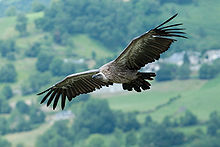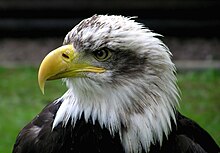Bird of prey
This article's use of external links may not follow Wikipedia's policies or guidelines. (April 2017) (Learn how and when to remove this template message) |
This article duplicates the scope of other articles. (December 2018) |

Griffon vulture
Birds of prey, or raptors, include species of bird that primarily hunt and feed on vertebrates that are large relative to the hunter. Additionally, they have keen eyesight for detecting food at a distance or during flight, strong feet equipped with talons for grasping or killing prey, and powerful, curved beaks for tearing flesh.[1][2][3] The term raptor is derived from the Latin word rapere, meaning to seize or take by force.[4] In addition to hunting live prey, most also eat carrion, at least occasionally, and vultures and condors eat carrion as their main food source.[1]
Although the term bird of prey could theoretically be taken to include all birds that primarily consume animals,[3]ornithologists typically use the narrower definition followed in this page.[citation needed] Examples of animal-eating birds not encompassed by the ornithological definition include storks, herons, gulls, skuas, penguins, kookaburras, and shrikes, as well as the many songbirds that are primarily insectivorous.
Contents
1 Common names
2 Systematics
2.1 Historical classifications
2.2 Modern systematics
2.3 Phylogeny
3 Migration
4 Sexual dimorphism
5 See also
6 Notes
7 References
8 Further reading
9 External links
Common names
The common names for various birds of prey are based on structure, but many of the traditional names do not reflect the evolutionary relationships between the groups.

Variations in shape and size
Eagles tend to be large birds with long, broad wings and massive feet. Booted eagles have legs and feet feathered to the toes and build very large stick nests.
Ospreys, a single species found worldwide that specializes in catching fish and builds large stick nests.
Kites have long wings and relatively weak legs. They spend much of their time soaring. They will take live vertebrate prey, but mostly feed on insects or even carrion.- The true hawks are medium-sized birds of prey that usually belong to the genus Accipiter (see below). They are mainly woodland birds that hunt by sudden dashes from a concealed perch. They usually have long tails for tight steering.
Buzzards are medium-large raptors with robust bodies and broad wings, or, alternatively, any bird of the genus Buteo (also commonly known as "hawks" in North America, while "buzzard" is colloquially used for vultures).
Harriers are large, slender hawk-like birds with long tails and long thin legs. Most use a combination of keen eyesight and hearing to hunt small vertebrates, gliding on their long broad wings and circling low over grasslands and marshes.
Vultures are carrion-eating raptors of two distinct biological families: the Accipitridae, which occurs only in the Eastern Hemisphere; and the Cathartidae, which occurs only in the Western Hemisphere. Members of both groups have heads either partly or fully devoid of feathers.
Falcons are medium-size birds of prey with long pointy wings. They belong to the Falconidae family, rather than the Accipitridae (accipiters). Many are particularly swift flyers.
Caracaras are a distinct subgroup of the Falconidae unique to the New World, and most common in the Neotropics – their broad wings, naked faces and appetites of a generalist suggest some level of convergence with either the Buteos or the vulturine birds, or both.
Owls are variable-sized, typically night-specialized hunting birds. They fly almost silently due to their special feather structure that reduces turbulence. They have particularly acute hearing.
Many of these English language group names originally referred to particular species encountered in Britain. As English-speaking people travelled further, the familiar names were applied to new birds with similar characteristics. Names that have generalised this way include: kite (Milvus milvus), sparrow-hawk or sparhawk (Accipiter nisus), goshawk (Accipiter gentilis), kestrel (Falco tinninculus), hobby (Falco subbuteo), harrier (simplified from "hen-harrier", Circus cyaneus), buzzard (Buteo buteo).
Some names have not generalised, and refer to single species (or groups of closely related (sub)species): merlin (Falco columbarius), osprey (Pandion haliaetus).
Systematics
Historical classifications
The taxonomy of Carl Linnaeus grouped birds (class Aves) into orders, genera, and species, with no formal ranks between genus and order. He placed all birds of prey into a single order, Accipitres, subdividing this into four genera: Vultur (vultures), Falco (eagles, hawks, falcons, etc.), Strix (owls), and Lanius (shrikes). This approach was followed by subsequent authors such as Gmelin, Latham, and Turnton.
Louis Pierre Veillot used additional ranks: order, tribe, family, genus, species. Birds of prey (order Accipitres) were divided into diurnal and nocturnal tribes; the owls remained monogeneric (family Ægolii, genus Strix), whilst the diurnal raptors were divided into three families: Vulturini, Gypaëti, and Accipitrini.[5]
Thus Veillot's families were similar to the Linnaean genera, with the difference that shrikes were no longer included amongst the birds of prey. In addition to the original Vultur and Falco (now reduced in scope), Veillot adopted four genera from Savigny: Phene, Haliæetus, Pandion, and Elanus. He also introduced five new genera of vultures (Gypagus, Catharista, Daptrius, Ibycter, Polyborus)[note 1] and eleven new genera of accipitrines (Aquila, Circaëtus, Circus, Buteo, Milvus, Ictinia, Physeta, Harpia, Spizaëtus, Asturina, Sparvius).
Modern systematics

Bald eagle
The order Accipitriformes is believed to have originated 44 million years ago when it split from the common ancestor of the secretarybird (Sagittarius serpentarius) and the accipitrid species.[6] The phylogeny of Accipitriformes is complex and difficult to unravel. Widespread paraphylies were observed in many phylogenetic studies.[7][8][9][10][11] More recent and detailed studies show similar results.[12] However, according to the findings of a 2014 study, the sister relationship between larger clades of Accipitriformes was well supported (e.g. relationship of Harpagus kites to buzzards and sea eagles and these latter two with Accipiter hawks are sister taxa of the clade containing Aquilinae and Harpiinae).[6]
The diurnal birds of prey are formally classified into five families of two orders.
Accipitridae: hawks, eagles, buzzards, harriers, kites, and Old World vultures
Pandionidae: the osprey
Sagittariidae: the secretarybird
Falconidae: falcons, caracaras, and forest falcons
Cathartidae: New World vultures
These families were traditionally grouped together in a single order Falconiformes but are now split into two orders, the Falconiformes and Accipitriformes. The Cathartidae are sometimes placed separately in an enlarged stork family, Ciconiiformes, and may be raised to an order of their own, Cathartiiformes.
The secretary bird and/or osprey are sometimes listed as subfamilies of Acciptridae: Sagittariinae and Pandioninae, respectively.
Australia's letter-winged kite is a member of the family Accipitridae, although it is a nocturnal bird.
The nocturnal birds of prey – the owls – are classified separately as members of two extant families of the order Strigiformes:
Strigidae: "typical owls"
Tytonidae: barn and bay owls
Phylogeny
Below is a simplified phylogeny of Telluraves which is the clade where the birds of prey belong to along with passerines and several near-passerine lineages.[13][14][15] The orders in bold text are birds of prey orders; this is to show the polyphly of the group as well as their relationships to other birds.
.mw-parser-output table.clade{border-spacing:0;margin:0;font-size:100%;line-height:100%;border-collapse:separate;width:auto}.mw-parser-output table.clade table.clade{width:100%}.mw-parser-output table.clade td{border:0;padding:0;vertical-align:middle;text-align:center}.mw-parser-output table.clade td.clade-label{width:0.8em;border:0;padding:0 0.2em;vertical-align:bottom;text-align:center}.mw-parser-output table.clade td.clade-slabel{border:0;padding:0 0.2em;vertical-align:top;text-align:center}.mw-parser-output table.clade td.clade-bar{vertical-align:middle;text-align:left;padding:0 0.5em}.mw-parser-output table.clade td.clade-leaf{border:0;padding:0;text-align:left;vertical-align:middle}.mw-parser-output table.clade td.clade-leafR{border:0;padding:0;text-align:right}
Telluraves |
| ||||||||||||||||||||||||||||||||||||
| |
Migration
Migratory behaviour evolved multiple times within accipitrid raptors.

An obliged point of transit of the migration of the birds of prey is the bottleneck-shaped Strait of Messina, Sicily, here seen from Dinnammare mount, Peloritani.
The earliest event occurred nearly 14 to 12 million years ago. This result seems to be one of the oldest dates published so far in the case of birds of prey.[6] For example, a previous reconstruction of migratory behaviour in one Buteo clade[11] with a result of the origin of migration around 5 million years ago was also supported by that study.
Migratory species of raptors had a southern origin because it seems that all of the major lineages within Accipitridae had an origin to one of the biogeographic realms of the Southern Hemisphere. The appearance of migratory behaviour occurred in the tropics parallel with the range expansion of migratory species to temperate habitats.[6] Similar results of southern origin in other taxonomic groups can be found in the literature.[16][17][18]
Distribution and biogeographic history highly determine the origin of migration in birds of prey. Based on some comparative analyses, diet breadth also has an effect on the evolution of migratory behaviour in this group,[6] but its relevance needs further investigation. The evolution of migration in animals seems to be a complex and difficult topic with many unanswered questions.
A recent study discovered new connections between migration and the ecology, life history of raptors. A brief overview from abstract of the publish paper shows that "clutch size and hunting strategies have been proved to be the most important variables in shaping distribution areas, and also the geographic dissimilarities may mask important relationships between life history traits and migratory behaviours. The West Palearctic-Afrotropical and the North-South American migratory systems are fundamentally different from the East Palearctic-Indomalayan system, owing to the presence versus absence of ecological barriers."[19] Maximum entropy modelling can help in answering the question: why species winters at one location while the others are elsewhere. Temperature and precipitation related factors differ in the limitation of species distributions. "This suggests that the migratory behaviours differ among the three main migratory routes for these species"[19] which may have important consevational consequences in the protection of migratory raptors.
Sexual dimorphism

Shikra females have yellow eyes
Raptors are known to display patterns of sexual dimorphism. It is commonly believed that the dimorphisms found in raptors occur due to sexual selection or environmental factors. In general, hypotheses in favor of ecological factors being the cause for sexual dimorphism in raptors are rejected. This is because the ecological model is less parsimonious, meaning that its explanation is more complex than that of the sexual selection model. Additionally, ecological models are much harder to test because a great deal of data is required.[20]
Dimorphisms can also be the product of intrasexual selection between males and females. It appears that both sexes of the species play a role in the sexual dimorphism within raptors; females tend to compete with other females to find good places to nest and attract males, and males competing with other males for adequate hunting ground so they appear as the most healthy mate.[21]
It has also been proposed that sexual dimorphism is merely the product of disruptive selection, and is merely a stepping stone in the process of speciation, especially if the traits that define gender are independent across a species. Sexual dimorphism can be viewed as something that can accelerate the rate of speciation.[22]
In non-predatory birds, males are typically larger than females. However, in birds of prey, the opposite is the case. For instance, the kestrel is a type of falcon in which males are the primary providers, and the females are responsible for nurturing the young. In this species, the smaller the kestrels are, the less food is needed and thus, they can survive in environments that are harsher. This is particularly true in the male kestrels. It has become more energetically favorable for male kestrels to remain smaller than their female counterparts because smaller males have an agility advantage when it comes to defending the nest and hunting. Larger females are favored because they can incubate larger numbers of offspring, while also being able to breed a larger clutch size.[23]
See also
- Origin of birds
 Birds portal
Birds portal
Notes
^ Veillot included the caracaras (Daptrius, Ibycter, and Polyborus) in Vulturini, though it is now known that they are related to falcons.
References
^ ab Perrins, Christopher, M; Middleton, Alex, L. A., eds. (1984). The Encyclopaedia of Birds. Guild Publishing. p. 102..mw-parser-output cite.citation{font-style:inherit}.mw-parser-output q{quotes:"""""""'""'"}.mw-parser-output code.cs1-code{color:inherit;background:inherit;border:inherit;padding:inherit}.mw-parser-output .cs1-lock-free a{background:url("//upload.wikimedia.org/wikipedia/commons/thumb/6/65/Lock-green.svg/9px-Lock-green.svg.png")no-repeat;background-position:right .1em center}.mw-parser-output .cs1-lock-limited a,.mw-parser-output .cs1-lock-registration a{background:url("//upload.wikimedia.org/wikipedia/commons/thumb/d/d6/Lock-gray-alt-2.svg/9px-Lock-gray-alt-2.svg.png")no-repeat;background-position:right .1em center}.mw-parser-output .cs1-lock-subscription a{background:url("//upload.wikimedia.org/wikipedia/commons/thumb/a/aa/Lock-red-alt-2.svg/9px-Lock-red-alt-2.svg.png")no-repeat;background-position:right .1em center}.mw-parser-output .cs1-subscription,.mw-parser-output .cs1-registration{color:#555}.mw-parser-output .cs1-subscription span,.mw-parser-output .cs1-registration span{border-bottom:1px dotted;cursor:help}.mw-parser-output .cs1-hidden-error{display:none;font-size:100%}.mw-parser-output .cs1-visible-error{font-size:100%}.mw-parser-output .cs1-subscription,.mw-parser-output .cs1-registration,.mw-parser-output .cs1-format{font-size:95%}.mw-parser-output .cs1-kern-left,.mw-parser-output .cs1-kern-wl-left{padding-left:0.2em}.mw-parser-output .cs1-kern-right,.mw-parser-output .cs1-kern-wl-right{padding-right:0.2em}
^ Fowler, D.W.; Freedman, E.A.; & Scannella, J.B. (2009). "Predatory Functional Morphology in raptors: Interdigital Variation in Talon Size Is Related to Prey Restraint and Immobilisation Technique". PLoS ONE. 4 (11): e7999. doi:10.1371/journal.pone.0007999. PMC 2776979. PMID 19946365.
^ ab Burton, Philip (1989). Birds of Prey. illustrated by Boyer, Trevor; Ellis, Malcolm; Thelwell, David. Gallery Books. p. 8. ISBN 978-0-8317-6381-7.
^ Brown, Leslie (1997). Birds of Prey. Chancellor Press. ISBN 978-1-85152-732-8.
^ Veillot, Louis Pierre (1816). Saunders, Howard, ed. Analyse d'une nouvelle ornithologie élémentaire (in French) (London 1883 ed.). Willughby Society.
^ abcde Nagy, J.; Tökölyi, J. (2014). "Phylogeny, historical biogeography and the evolution of migration in accipitrid birds of prey (Aves: Accipitriformes)" (PDF). Ornis Hungarica. 22 (1): 15–35. doi:10.2478/orhu-2014-0008.
^ Motta-Junior, et. al. (eds.) (2004). Raptors worldwide (PDF). Berlin: WWGBP. pp. 483–498.CS1 maint: Extra text: authors list (link)
^ Helbig, A. J.; Kocum, A.; Seibold, I.; Braun, M. J. (2005). "A multi-gene phylogeny of aquiline eagles (Aves: Accipitriformes) reveals extensive paraphyly at the genus level". Molecular Phylogenetics and Evolution. 35 (1): 147–164. doi:10.1016/j.ympev.2004.10.003. PMID 15737588.
^ Lerner, H. R. L.; Mindell, D. P. (2005). "Phylogeny of eagles, Old World vultures, and other Accipitridae based on nuclear and mitochondrial DNA" (PDF). Molecular Phylogenetics and Evolution. 37 (2): 327–346. doi:10.1016/j.ympev.2005.04.010. PMID 15925523.
^ Griffiths, C. S.; Barrowclough, G. F.; Groth, J. G.; Mertz, L. A. (2007). "Phylogeny, diversity, and classification of the Accipitridae based on DNA sequences of the RAG-1 exon". Journal of Avian Biology. 38 (5): 587–602. doi:10.1111/j.2007.0908-8857.03971.x.
^ ab do Amaral, F. R., et. al. (2009). "Patterns and processes of diversification in a widespread and ecologically diverse avian group, the buteonine hawks (Aves, Accipitridae)" (PDF). Molecular Phylogenetics and Evolution. 53 (3): 703–715. doi:10.1016/j.ympev.2009.07.020. PMID 19635577.
^ Breman, F. C., et. al. (2013). "DNA barcoding and evolutionary relationships in Accipiter Brisson, 1760 (Aves, Falconiformes: Accipitridae) with a focus on African and Eurasian representatives". Journal of Ornithology. 154 (1): 265–287. doi:10.1007/s10336-012-0892-5.
^ Yuri, T.; et al. (2013). "Parsimony and Model-Based Analyses of Indels in Avian Nuclear Genes Reveal Congruent and Incongruent Phylogenetic Signals". Biology. 2 (1): 419–444. doi:10.3390/biology2010419. PMC 4009869. PMID 24832669.
^ Ericson, P. G. (2012). "Evolution of terrestrial birds in three continents: biogeography and parallel radiations" (PDF). Journal of Biogeography. 39 (5): 813–824. doi:10.1111/j.1365-2699.2011.02650.x.
^ Jarvis, E. D.; Mirarab, S.; Aberer, A. J.; Li, B.; Houde, P.; Li, C.; Ho, S. Y. W.; Faircloth, B. C.; Nabholz, B.; Howard, J. T.; Suh, A.; Weber, C. C.; Da Fonseca, R. R.; Li, J.; Zhang, F.; Li, H.; Zhou, L.; Narula, N.; Liu, L.; Ganapathy, G.; Boussau, B.; Bayzid, M. S.; Zavidovych, V.; Subramanian, S.; Gabaldon, T.; Capella-Gutierrez, S.; Huerta-Cepas, J.; Rekepalli, B.; Munch, K.; et al. (2014). "Whole-genome analyses resolve early branches in the tree of life of modern birds" (PDF). Science. 346 (6215): 1320–1331. doi:10.1126/science.1253451. PMC 4405904. PMID 25504713.
^ Joseph, L.; Lessa, E. P.; Christidis, L. (1999). "Phylogeny and biogeography in the evolution of migration: shorebirds of the Charadrius complex". Journal of Biogeography. 26 (2): 329–342. doi:10.1046/j.1365-2699.1999.00269.x.
^ Outlaw, D. C., et. al. (2003). "Evolution of long-distance migration in and historical biogeography of Catharus thrushes: a molecular phylogenetic approache". The Auk. 120: 299–310. doi:10.1642/00048038(2003)120[0299:EOLMIA]2.0.CO;2 (inactive 2018-11-19). JSTOR 4090182.
^ Milá, B.; Smith, T. B.; Wayne, R. K. (2006). "Postglacial population expansion drives the evolution of long–distance migration in a songbird". Evolution. 60 (11): 2403–2409. doi:10.1111/j.0014-3820.2006.tb01875.x. PMID 17236431.
^ ab Nagy, Jenő; Végvári, Zsolt; Varga, Zoltán (2016). "Life history traits, bioclimate, and migratory systems of accipitrid birds of prey (Aves: Accipitriformes)". Biological Journal of the Linnean Society. 121: 63–71. doi:10.1093/biolinnean/blw021.
^ Mueller, H.C. "The Evolution of Reversed Sexual Dimorphism in Owls: An Empirical Analysis of Possible Selective Factors". The Wilson Bulletin. 98 (3): 387–406.
^ Wiehn, J.; Korpimakki, E.; Massemin, S. (2000). "Reversed sexual size dimorphism in raptors: evaluation of the hypotheses in kestrels breeding in a temporally changing environment". Oecologia. 124 (1): 26–32. doi:10.1007/s004420050021. PMID 28308409.
^ BOLNICK, David; DOEBEL, Michael (November 2003). "SEXUAL DIMORPHISM AND ADAPTIVE SPECIATION: TWO SIDES OF THE SAME ECOLOGICAL COIN". The Society of Evolution. 57 (11).
^ Sonerud, G; Steen, R; Low, L; Roed, L.; Skar, K.; Selas, V; Slagsvold, T (2013). "Size-biased allocation of prey from male to offspring via female: family conflicts, prey selection, and evolution of sexual size dimorphism in raptors". Oceologa. 172 (1): 93–107. doi:10.1007/s00442-012-2491-9. PMID 23073637.
Further reading
Brown, Leslie (2013). British birds of prey : a study of Britain's 24 diurnal raptors. Hammersmith, London: HarperCollins Publishers. ISBN 9780007406487.
Dunne, Pete; Karlson, Kevin (2017). Birds of Prey Hawks, Eagles, Falcons, and Vultures of North America. Houghton Mifflin Harcourt. ISBN 9780544018440. OCLC 953709935.
Macdonald Lockhart, James (2017). Raptor : a journey through birds. Chicago: The University of Chicago Press. ISBN 9780226470580. OCLC 959200538.
Mackenzie, John P. S. (1997). Birds of prey. Toronto, Ont: Key Porter Books. ISBN 9781550138030. OCLC 37041161.
Newman, Kenneth (1999). Kenneth Newman's birds of prey of southern Africa : rulers of the skies : an identification guide to 67 species of southern African raptors. Knysna, South Africa: Korck Pub. ISBN 978-0620245364. OCLC 54470834.
- Olsen, Jerry 2014, Australian High Country raptors, CSIRO Publishing, Melbourne,
ISBN 9780643109162. - Remsen, J. V. Jr., C. D. Cadena, A. Jaramillo, M. Nores, J. F. Pacheco, M. B. Robbins, T. S. Schulenberg, F. G. Stiles, D. F. Stotz, and K. J. Zimmer. [Version 2007-04-05.] A classification of the bird species of South America. American Ornithologists' Union. Accessed 2007-04-10.
Yamazaki, Tour (2012). Field guide to Raptors of Asia. London: Asian Raptor research and Conservation Network. ISBN 9786021963531. OCLC 857105968.
External links
Bird of prey at Encyclopædia Britannica
Explore Birds of Prey with The Peregrine Fund
Birds of Prey on the Internet Bird Collection- Bird of Prey Pictures
- Global Raptor Information Network
- The Arboretum at Flagstaff's Wild Birds of Prey Program
- Raptor Resource Project
- Owls pages
- Birds of Prey and the difference between Diurnal and Nocturnal Birds of Prey



